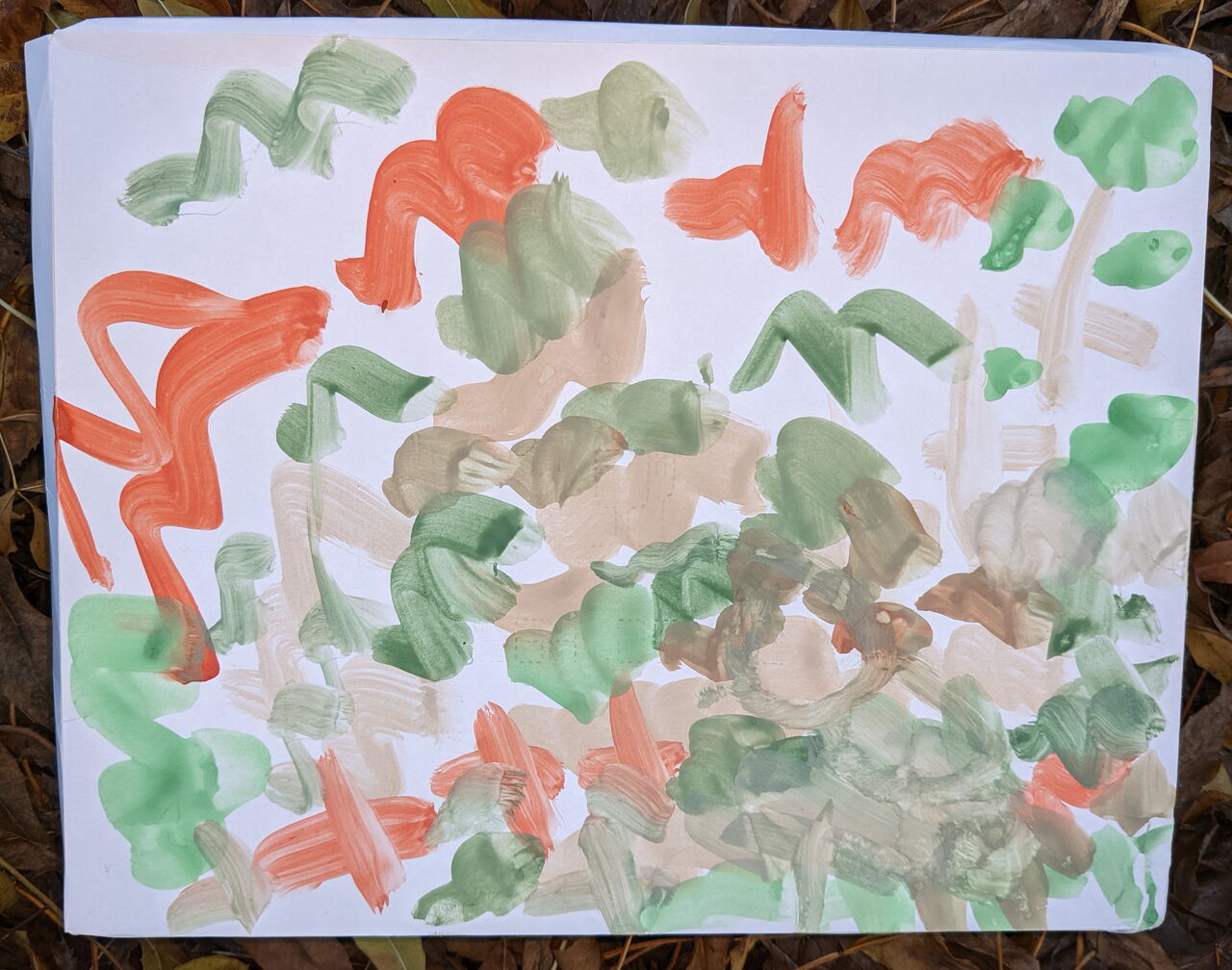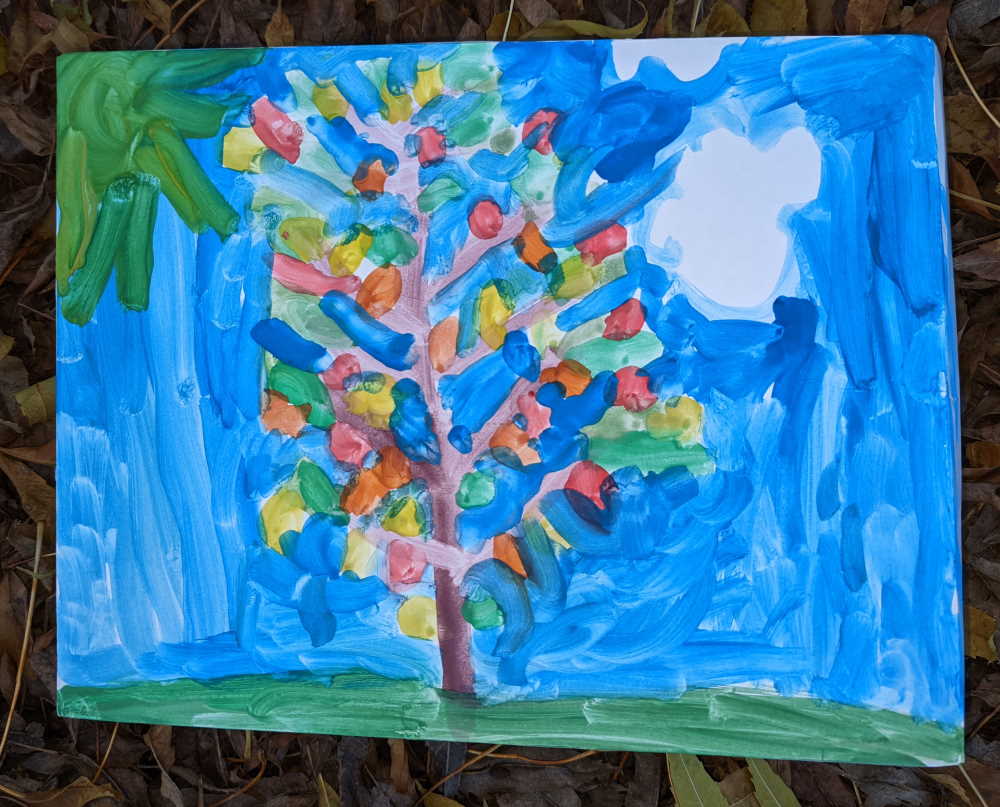Vernacular Magic
Arcane arts with witchlings – for what is this but child’s play?
While I was summoning love spell and ritual, I kept in mind a book by revered Finnish writer and artist Tove Jansson (known outside Scandinavia for her illustrated Moomin tales). Although The Summer Book remained unread, its cover of a tiny, pine-cloaked rocky island floating between a cerulean sea and sky somewhere in the Gulf of Finland silently sustained me. I was apprehensive about opening this ‘European literary gem’ depicting the relationship between an elderly artist and her 6-year-old granddaughter, daunted by the writer’s adept depictions of the perceptions and thought processes of both a child and a wise crone. Nevertheless, I wanted to give light to the experience of being with small beloveds, in a patch of familiar nature. Time slowing as we witness ants scurrying up and down the rosemary’s lilac-topped towers, an hour or two before the rain. Losing ourselves when painting and making solely for our own pleasure.
Words become amulets.
We chant and become enchanted.
Carry love in our orange beaks.
Welcome strangers with gestures of care.
This is how it feels to be alive.
With our ancestors and one another.
We are here.
In the now.
vignette 01: love spell
We rescued the patio from seasons of neglect, transforming the glass-topped table into a painting and collage studio. Kids perch on too-large chairs, facing west. Unruly Kikuyu resists sprawling rosemary, nettles, parsley, Greek basil, mint. Around the perimeter: peach, apricot, nectarine, plum, olive, lemon, orange, and magnolia. Queen is the Shadow Tree, named some summers ago, when we would climb the late afternoon branches it cast on the grass. The only tree remaining which had witnessed both my son’s childhood, and my own.
Eighteen discs of colour rest in three plastic palettes, next to a quiver of brushes. The two children love painting on eggshell-white Mantovanelle pasta boxes, once nests for wheels of tagliatelle, fettuccine, swathes of fine golden angel hair. Now a perfect size and weight for still life, landscapes, self-portraits, patterns, treasure maps, colour fields. One day, the girl steps into Surrealism, her painting titled “Mixed-up world” depicting brother floating in the sky, tadpoles swimming in air, a fly with no wings, bombs flying upwards. Imagination materialising other realities.
It’s Friday. Sister’s at school, leaving brother and I in companionable silence. Four years old, an age when language bubbles out, carrying almost imperceptible traces of an ancient spring. Chooses colours carefully, never more than three or four. Starts a series of wavy lines, starred with crosses.
As brush sweeps the paper, he speaks, repeating the same phrase. Over and over, until he has finished painting.
I love you Mummy, I love you Mummy, I love you Mummy, I love you Mummy, I love you Mummy.
A love spell. With heart and mind, lips and tongue and throat, he sends his intention through the ether. Transmits to his beloved, the one who grew him from a seed tinier than those the black ants are hauling as they emerge through a sandy latticed crostata beneath his feet.
Rain must be on its way.

vignette 02: ritual
“You are old enough now,” her grandmother whispered. “The magic skips a generation. Your mother doesn’t have it but I see it in you. It lights up your skin when you sleep. You need to be trained just as my grandmother trained me when I was your age. I need to pass on the secret to you.”
“What secret?”
“So many secrets. But for today? We learn what to do with the whey.”
— Krissy Kneen, The Three Burials of Lottie Kneen: Travels With my Grandmother’s Ashes
When did we start performing rituals? I’d need to dig into the middens of photos, but it’s too daunting, easier to guess. Probably some months before the girl turned three, after we had breathed agency into a knotwork of knitted oddities, clackety-clacked into being by countless crones’ hands. At seven, the girl is bound to our peculiar familiars still, recasting roles in shapeshifting scenarios. Ragamuffins in her school of sums and smacks. Restaurant patrons. Witnesses at a triple wedding.
She first marries me to her brother, then herself to me, then she and her brother exchange wands and flowers. A minor squabble over one of the four rings, quickly resolved. The constancy of cooperation brings us closer. With words and kisses we form dynastic ties under the disinterested gaze of Peepo, Hedgehog, and dandy Mr. Rupert. Then dancing, and a feast of pretzels, cheese, cucumbers.
te quiero, niño
ti amo, piccolina
ti amo tantissimo
❧
Seasonal rituals, suggested by nature not narrative, more abstract in content and form. Fungible ingredients gleaned from gardens and footpaths. Steps devised on the run, open to alteration. These differ from our everyday spells and potions as there is rarely a stated intention. We perform simple unceremonies for the pure pleasure of being present in the present moment.
The girl and I have spent years scrawling chalk circles and numerals, building pyres of autumn leaves adorned with shells, laying out little ley lines of elm twigs and magpie feathers. Her brother joins us. I’m four now, he says. Like his sister, he’s an adept of numbers, patterns, casting shapes, chess.
These spectral beings, my beloveds, wreaths of Sweet William, Holly and Heartsease upon our heads.
Wild Pansy. Love-Lies-me-to-you. Jack-Jump-up-and-Kiss-me. Meet-me-in-the-Entry. Kiss-her-in-the-Buttery. Three-Faces-under-a-Hood. Kit-run-in-the-Fields. Pink-o'-the-Eye. Godfathers and Godmothers. Herb Constancy. Flower o'Luce. Bird's Eye. Pensée.
Under the Shadow Tree’s protection, we follow the moon, try our hand at telepathy, speak to the star people. We practise our arcane arts freely, for what is this but child’s play? We’re improvising as we go, lineages to those who went before severed by migration, madness, death.
This vernacular magic.
We’re making it for ourselves.
For accomplices and strangers.
For those who are here, and those who will follow.
For animals, vegetables, minerals.
Meanwhile around the world, people, especially women and children, are being increasingly persecuted and slaughtered under an expanding regime of enclosures cloaked as witchcraft.
Silvia Federici
❧
We pass local by-election posters on the way home from school.
In Australia the Reds are the centre-left Labor Party, the Blues are the centre-increasingly right Liberal Party.
I’m voting for Reds, the girl says.
I’m voting for Greens, the boy says.
I can’t believe that the Blues won!, she says the following week.
But the Greens and Reds did better than ever, I respond.
Back home we console ourselves with mandarins, Spanish songs, checkmate in four moves.
In her book “Witches, Witch-hunting and Women” feminist activist, scholar and teacher Silvia Federici discusses how accusationsand punishments for so-called witchcraft are manifesting around the world – in Tanzania, Central African Republic, Ghana, Nepal, Papua New Guinea, Saudi Arabia and elsewhere. The contemporary witch-hunt “is rooted in structural trends that are constitutive of capitalist development and state power in all times”. Moreover, “witch hunters have operated with impunity, even in daylight”. To counter such “terror campaigns” and the “ultimate mechanism of alienation and estrangement”, feminist solidarity movements and direct action are emerging.
❧
One year later, the girl announces that when she grows up, she wants to help people to experience and identify their emotions. Her clients can be anywhere between three and 100 years of age. She will be an artist too, and make books. She then returns to brewing potions in her Minecraft home, placing them in her treasure chest. A witchling’s work is never done!

vignette 03: burial rites
The I Ching, or Book of Changes, is a book of oracles and wisdom that has influenced Confucian and Taoist philosophy for three thousand years. Its core theme is ‘continuous change and transformation underlying all existence’. Its divination method involves throwing three coins six times, or dividing a bundle of 49 yarrow stalks, producing one of 64 hexagrams composed of two sets of three stacked lines. Synchronicity (on a universal plane) and context (material externalities particular to any given situation) guide the diviner’s interpretation of the answer to the question posed. The format of Burial Rites, using ‘the image’ and positional lines, is inspired by The I Ching.
hound
the image
first burial
familiar / piebald border collie
place her beneath the lemon tree to catch the winter sun
sow a bed of saffron marigolds and violet lobelia
the lines
six in the third place means:
magicians are used in great number
a skull barking the future
cat
the image
second burial
familiar / black cat
still warm, we wash him
sleek with sea-sprayed tears and tea tree oil
the lines
nine at the top means:
once rain falls, remorse is spent
a skull safekeeping the past
mother
the image
third burial
witch / oracle / sky traveller in a golden sphere
rising full moon laughs over the resting giant, blowing stardust over us
an imperial purple velvet pouch adorned with emu feathers
the lines
nine at the beginning means:
she veils her light, yet still shines
bone ash witnessing the present
granddaughter
the image
fourth burial
empath witchling / artist / healer
placenta takes the form of a beating heart
the lines
six at the top means:
it furthers one to undertake something
present becoming future
grandson
the image
fifth burial
pattern witchling / linguist / mathematician
placenta takes the form of a breathing lung
the lines
nine at the beginning means:
joy comes softly
future becoming present
Figments of Affordable Mysticism
❧
Further reading and references